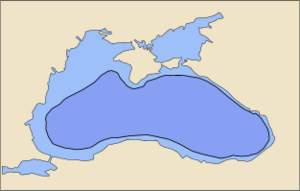Megaflood facts for kids
Imagine a super-big flood that suddenly lets out a huge amount of water. That's a megaflood! Scientists sometimes call it an outburst flood. Many megafloods happened at the end of the last ice age. Huge ice sheets or glaciers acted like natural dams, holding back massive lakes. When these ice dams broke, a megaflood happened.
We know about even older megafloods from Earth's long history. Sometimes, landslides, mudflows (called lahars), or volcanic eruptions can block rivers. This creates big lakes. If the rock or earth barrier breaks or wears away, it causes a giant flood. Lakes can also form behind piles of rock and dirt left by glaciers, called moraines. These moraine dams can also collapse and cause outburst floods.
Contents
Amazing Ancient Megafloods
The Black Sea Mystery (About 7,600 Years Ago)
Some scientists believe a huge flood refilled the Black Sea about 7,600 years ago. Before this, the Black Sea was a freshwater lake. Water from the Aegean Sea (part of the Mediterranean) supposedly rushed in.
This event is described as a "violent rush of salt water." It poured into the freshwater lake in one big disaster. Some people think this event inspired ancient flood stories and myths.
This flood was likely caused by the Mediterranean Sea's water level rising. However, geologists still debate if this flood really happened. The idea that it led to flood myths is also not fully proven.
The Caspian and Black Sea Connection (Around 16,000 Years Ago)
Another idea about the Black Sea flood comes from Andrey Tchepalyga. He is a scientist from the Russian Academy of Sciences. He thinks the Black Sea basin flooded much earlier.
Around 16,000 years ago, global warming started melting the ice sheet in Scandinavia. This caused a huge amount of river water to flow into the Caspian Sea. The Caspian Sea couldn't hold all this water. So, it overflowed into the ancient Black Sea basin.
This would have flooded huge areas. These areas were once home to people or used for hunting. Tchepalyga suggests this massive flood might be the basis for legends of the great Deluge (or Great Flood).
How the English Channel Formed
Long ago, a strip of land connected Britain to mainland Europe. This land was across what is now the Strait of Dover. During an earlier ice age, a huge ice dam blocked the exit from the North Sea to the north.
This caused rivers to back up. A huge lake formed on the seabed where the North Sea is now. A gentle chalk ridge connected the Weald of Kent in England and Artois in France. This ridge was about 30 meters (100 feet) higher than today's sea level.
At some point, this natural barrier broke. This probably happened around 425,000 years ago. It happened again about 225,000 years later.
This breaking unleashed a giant flood. It redirected the Rhine River into the English Channel. This event separated Britain from Europe. A special study of the English Channel seabed using sonar showed clear signs of this megaflood.
Refilling the Mediterranean Sea (5.3 Million Years Ago)
A massive flood refilled the Mediterranean Sea 5.3 million years ago. This flood happened when water from the Atlantic Ocean found its way through the Strait of Gibraltar.
At that time, the Mediterranean basin was a dry salt lake and salt bed. The Atlantic waters rushed in, filling it up in a catastrophic event.
Glacial Lake Floods in North America
During the last ice age, North America didn't have the Great Lakes as we know them. Instead, "proglacial" lakes formed near the edges of the ice sheets. The most famous of these was Lake Agassiz.
Melting ice caused a series of huge floods from Lake Agassiz. These floods added massive amounts of freshwater to the world's oceans.
The last of these large proglacial lakes was north of today's Great Lakes. It reached its biggest size about 8,500 years ago. It even joined with Lake Agassiz. But a huge wall of glaciers blocked its usual outlet. So, it drained through rivers like the Ottawa River and Saint Lawrence River far to the south.
Around 8,300 to 7,700 years ago, the ice dam holding back this lake broke. This was a catastrophic event. The old shorelines of this lake, called Lake Ojibway, show it was 250 meters (820 feet) above sea level.
Scientists estimate Lake Ojibway held about 163,000 cubic kilometers of water. That's enough water to cover a flat Antarctica with a sheet of water 10 meters (33 feet) deep! This huge amount of water was added to the world's oceans in just a few months.
Scientists are still studying the exact timing and speed of these changes. They want to understand what happened after the giant ice sheets started melting.
Floods from Landslide Lakes
Sometimes, a landslide can block a river and create a lake. If this natural dam breaks, it can cause a huge flood.
One example happened on Sichuan's Dadu River in China. A landslide dam burst on June 10, 1786. This caused a flood that stretched 1,400 kilometers (870 miles) downstream. Sadly, it killed 100,000 people. This was one of the worst landslide-related disasters in history.


